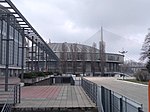House of King Petar I Karađorđević
Buildings and structures in BelgradeManor houses in SerbiaSavski Venac

The house of King Petar I Karađorđević is located in Belgrade, on the territory of the city municipality of Savski venac. When King Petar I Karađorđević after five years returned from the First World War, in 1919, the old court was destroyed in war, so it was important to find the house in which the king was supposed to live. The merchant Đorđe Pavlović's was chosen, and in that house King Petar I spent the last two years of his life. King Petar I moved into that house on Senjak, on 24 September 1919, and lived in it until 16 August 1921. He died in this house. This house represents the immovable cultural property as the cultural monument.
Excerpt from the Wikipedia article House of King Petar I Karađorđević (License: CC BY-SA 3.0, Authors, Images).House of King Petar I Karađorđević
Владете Ковачевића, Belgrade Београд (Савски венац)
Geographical coordinates (GPS) Address Nearby Places Show on map
Geographical coordinates (GPS)
| Latitude | Longitude |
|---|---|
| N 44.790919 ° | E 20.438839 ° |
Address
Владете Ковачевића 8
11000 Belgrade, Београд (Савски венац)
Central Serbia, Serbia
Open on Google Maps





